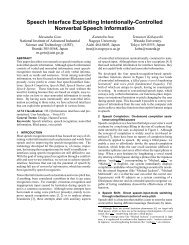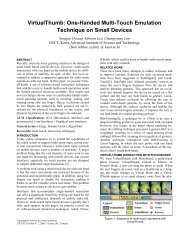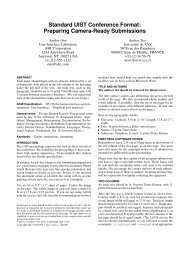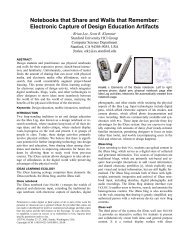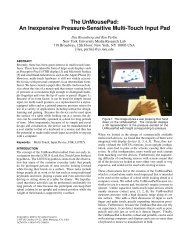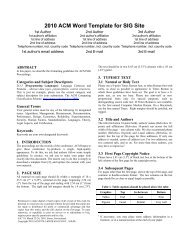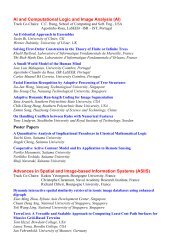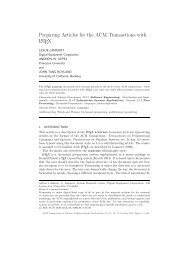API Design Matters Stonebraker and Seltzer - RabbitMQ
API Design Matters Stonebraker and Seltzer - RabbitMQ
API Design Matters Stonebraker and Seltzer - RabbitMQ
You also want an ePaper? Increase the reach of your titles
YUMPU automatically turns print PDFs into web optimized ePapers that Google loves.
story with an unfinished attic above <strong>and</strong> an unfinished<br />
crawl area below the living space. Both of those areas<br />
are available as cable pathways from the wiring closet to<br />
any network outlet in my house. Because of easy access,<br />
I opted for the unfinished crawl area for my cable runs,<br />
using large drive rings 7 (they are like big hooks) attached<br />
to exposed beams <strong>and</strong> floor joists every 18 inches or so to<br />
support the cable from the wiring closet to its destination<br />
directly underneath the room outlet.<br />
To install a flush-mount room outlet, you must first<br />
make its location visible to the unfinished attic or crawl<br />
space. In my case, I gently removed the floor molding<br />
right below where I wanted to place the outlet <strong>and</strong> drilled<br />
a small signal hole through the floor directly next to the<br />
wallboard. I threaded a piece of wire through the hole so<br />
it was visible in the crawl area below <strong>and</strong> then cut a hole<br />
in the wallboard to accommodate the plastic workbox.<br />
Back under the house the hanging wire became a<br />
guide to drill a one-inch hole through the flooring <strong>and</strong><br />
into the empty space inside the wall. I inserted the cable<br />
into the hole <strong>and</strong> pushed it through so it was visible to<br />
the cutout in the wall in the room above. I then pushed<br />
the cable through the cutout <strong>and</strong> the opening in the back<br />
of a plastic workbox. The box could then be installed in<br />
the cutout flush to the wallboard. I attached the RJ45<br />
connectors to the end of the cable <strong>and</strong> mounted them<br />
into the faceplate, which I then attached to the workbox<br />
in the wall. With the hanging wire removed <strong>and</strong> molding<br />
reinstalled, the signal hole was covered from view.<br />
If you do not have an attic or crawl space, you do have<br />
other options for installing a flush- or surface-mount<br />
outlet in or on a wall. If you have wall-to-wall carpet, you<br />
can pull it off the tack strip that runs along the wall, place<br />
cable in the space between the tack strip <strong>and</strong> wall, <strong>and</strong><br />
replace the carpet back onto the tack strip. Transitions<br />
across interior walls are easily done by drilling through<br />
the wall right at the level of the floor. If there are no<br />
carpets, you can try placing cable behind floor molding.<br />
Usually there is a space between the wallboard <strong>and</strong> the<br />
floor that will accommodate a cable. Similar strategies<br />
may work for door <strong>and</strong> ceiling molding. As a last resort,<br />
you can drill a hole through an exterior wall to the out-<br />
side of your home, run wiring around the outside of the<br />
house under the eaves, <strong>and</strong> back through the wall to its<br />
final destination. Plug the holes with silicon caulk.<br />
invEst in WirE<br />
Wi-Fi poses accessibility, availability, <strong>and</strong> b<strong>and</strong>width<br />
restrictions, as well as privacy <strong>and</strong> liability risks that I find<br />
unacceptable to my home networking needs. I often won-<br />
more queue: www.acmqueue.com<br />
der at the efforts <strong>and</strong> expense people will go to in order<br />
to avoid installing wires when it is obvious that wires<br />
are the best way to transmit information. If you look at<br />
any commercial setting, structured wiring is the primary<br />
networking platform; wireless is secondary. Given that<br />
home networking dem<strong>and</strong>s usually lag what is needed<br />
commercially, people should embrace wired networks for<br />
the home.<br />
With cable <strong>and</strong> wire closet terminations available from<br />
$150 <strong>and</strong> the parts costs for room outlets at between $5<br />
to $10 per room, the equipment costs for hardwiring<br />
your home are relatively inexpensive. The variable is<br />
how difficult it is to hide the cable running from the wire<br />
closet to the room outlet. With minimal home improve-<br />
ment skills <strong>and</strong> a forgiving home architecture, a commer-<br />
cial-grade wiring plant can easily <strong>and</strong> inexpensively be<br />
installed to provide rock-solid <strong>and</strong> secure service to every<br />
room in your house. I see it much like the transition from<br />
terrestrial broadcast TV to cable TV. Given the increas-<br />
ing dem<strong>and</strong>s you will be making on your home network<br />
environment, investing in a wired infrastructure will<br />
eventually be as common as wiring for cable TV. Q<br />
REFERENCES<br />
1. http://www.google.com/search?hl=en&q=aircrack&btn<br />
G=Google+Search.<br />
2. Belden Media Twist (part number 1872A) rated at CAT6<br />
-; http://www.belden.com/pdfs/MasterCatalogPDF/<br />
PDFS_links%20to%20docs/11_Networking/11.4.pdf.<br />
3. I used a Harris-Dracon D-814 punch-down h<strong>and</strong>le with<br />
a 110 punch-down blade.<br />
4. See the definition of 568A <strong>and</strong> 568B UTP Cable Termination<br />
St<strong>and</strong>ards at http://www.ablecables.com.<br />
au/568avb.htm.<br />
5. These vendors include Lucent, P<strong>and</strong>uit, Leviton, <strong>and</strong><br />
many others.<br />
6. You can find old plastic workboxes at any home<br />
improvement center for around $1.<br />
7. I used 1¼ -inch drive rings priced at around 25 cents a<br />
piece.<br />
LOVE IT, HATE IT? LET US KNOW<br />
feedback@acmqueue.com or www.acmqueue.com/forums<br />
MACHE CREEGER (mache@creeger.com) is a technology<br />
industry veteran based in Silicon Valley. He is the principal<br />
of Emergent Technology Associates, marketing <strong>and</strong><br />
business development consultants to technology companies<br />
worldwide.<br />
© 2007 ACM 1542-7730/07/0500 $5.00<br />
ACM QUEUE May/June 2007 15





